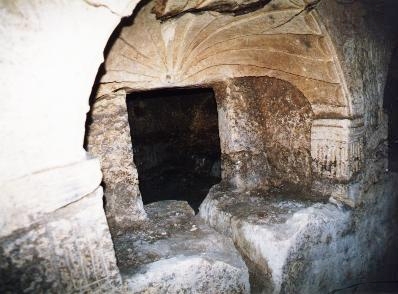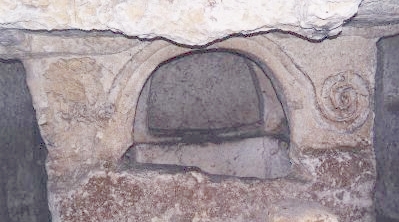
Although the Maltese late Roman and Byzantine catacombs
are not extensive in their size as those of Rome and Sicily, they are noteworthy
for the richness in the variety of tomb types they contain.
Loculus
The loculus consists of a rectangular recess in the wall of a catacombs usually reeserved for the burial of children. Those reserved for adults are much less numerous.
Floor Tomb
 |
This type of tomb is considered as a late type of tomb, resrted to when all the available space in a catacomb would have been used up. Places containing such tombs include Abbatija tad-Dejr and the Jesuit Hill hypogeum. Some floor tombs are found in the open air and include the Salina hypogea and a solitary example at il-Wied ta' Kandja. |
Arcosolium
| Two types of arcosolia are recorded from the Maltese Islands. The troughless type is probably the earlier and may be considered as an elaboration of the mortuary couch of the indigenous punico-phoenician tombs. The arcosolia with troughs may on the other hand know their origins from nearby Sicily, but the Maltese tombs only rarely have more than two troughs. Notable exceptions are the arcosolia which were documented in the Jesuit Hill III hypogeum, the St. Agatha catacombs and possibly the existed in the mutilated Ghar Gerduf catacomb in Gozo |  |
Window Tomb
 |
This type of tomb is quite common on the Maltese Islands and can be considered as a development from the entrances of punic chambers. The square window leads into an oval or rectangular chamber. A arched recess is usually found preceeding the entrance to the chamber. The niche of this recess may be plain but in occassions may be decorated. The same can be said of the two pilasters that are found on the sides of the recess. |

Saddle Tomb
 |
The saddle tomb may be considered as an elaboration of
the Baldacchino tomb. A saddle shaped cover to the tomb replaces the usual
entrance to the chambers which is now located on the side of the burial
chamber.
These tombs may be quite elaborate as in the case of the examples from Salina, and were probably reserved for distinctive personages. |
Reference:
BUHAGIAR M.; "Late Roman and Byzantine Catacombs and Related
Burial Places in the Maltese Islands"(1986): 19 - 24
GO BACK
Contact author by
E-Mail